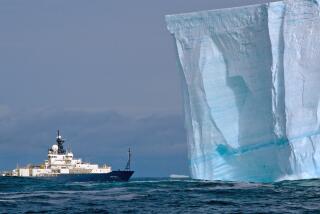Sailing the Arctic, expect big chills, quiet thrills
Longyearbyen, Norway
We are sailing up the fiord rimmed by mountains and ice, leaving the final outpost of civilization behind us.
It’s a September evening just past 11 o’clock at 81 degrees latitude, not far from the north pole.
Even this late in the year, the sun is still out, its slanted light illuminating the glaciers with a soft, pink glow as it hovers, seemingly forever, above the horizon.
The Arctic tundra lies before us quiet, undisturbed and magnificent.
During the next three days, the only other humans we will see are a couple of Russian sailors docked at a ghost town.
This is the most remarkable thing about the Arctic: its unspoiled stillness. There’s no white noise, no humming freeways, no helicopters hovering overhead. There’s just silence, occasionally interrupted by the birds, the waves and the wind taking hold, then letting go, of the sails.
Svalbard, a cluster of islands between Norway and the north pole, is a place of midnight sun, northern lights, natural wonders and dramatic contrasts. With the exception of the small town of Longyearbyen, the remote archipelago is rugged and wild.
I arrive in Longyearbyen with a plan to spend a few days onboard a sailboat built and owned by a 48-year-old Dutchman named Mark van de Weg. Since I went ice trekking on a glacier in Patagonia, Argentina, earlier in the year, glaciers have taken hold of my imagination.
I am not religious, but looking at glaciers, and contemplating what they represent, feels almost spiritual. They are magnificent to behold -- vast and with a surprising array of colors, including shades of blue, green and purple. Their continuous movement, even if by increments, is awe inspiring. Looking at glaciers is seeing our planet’s history: its past, present and future contained in one moment.
Because the ground is not covered entirely with snow, I know it will be impossible to travel overland on skis, by snow scooter or by dog sled. Besides, the boat offers an opportunity to get closer to the front of the glacier than you could ever be on land.
Researching my trip into the wilderness, I had fantasized about flying by helicopter farther north, camping on the ice and skiing across to the north pole, which isn’t on land but a frozen patch in the middle of the Arctic Sea. But my budget dictates a shorter trip. Van de Weg, whom I have found online, suggests by e-mail that we explore Isfjorden, literally “the ice fiord,” northeast of Longyearbyen.
Other adventure outfits offer trips around the fiords by icebreakers or powerful rubber dinghies. But Van de Weg is the only one who takes travelers by sailboat around Svalbard. There is not a lot of business to go around anyway. He gets only a handful of tourists every year. Most of his customers are scientists or professional nature photographers.
As the day of my departure draws near, I begin to wonder what I’ve gotten myself into. I have always loved sailing, but the idea of sailing around the icy waters of Svalbard is a tad scary -- but, of course, all the more exhilarating because of it.
When Van de Weg picks me up at the tiny Longyearbyen airport, the light is fading fast. Every day is about half an hour shorter than the previous day.
And it is getting noticeably colder. Temperatures approach 30 degrees, but it feels much colder because of the wind.
Van de Weg began coming to the Arctic in 1994 after circumnavigating the world in a traditional wooden sailboat. Five years ago, he wintered with his girlfriend and two guard dogs on a small sailboat stuck in the ice of a remote fiord. He felt like the king of the frozen bay, he says. “Enjoyable,” he adds, with a half-smile.
The Dutchman looks the part of an Arctic skipper with his ruddy complexion and solid 6-foot-4 frame.
As we set sail, the water is choppy at first, waves crashing against the hull and spraying the deck with icy water. But after a couple of hours, the sea calms down.
As I acclimatize to my new surroundings (cowering from the freezing cold in the small heated cabin), Van de Weg stands alone on deck for hours, steering without hat or gloves.
Vikings probably first visited the archipelago in the 12th century, referring to it as Svalbard, meaning “cold edge.” Willem Barents, a Dutch explorer for whom the Barents Sea is named, came upon the archipelago in 1596, and the islands became a center for whaling and Arctic exploration.
Today, about 2,000 people live in Longyearbyen, working in coal mining, Arctic research or adventure tourism.
No one is born on the islands -- everyone comes from somewhere else. Because life here is physically demanding, the population is generally young and fit.
Because of its size and peculiar characteristics -- everyone knows one another and there is nowhere to hide -- there are no visible social problems and no measurable crime. An introduction to Svalbard puts it like this: “A small amount of hobby-anarchism is accepted but if you break Norwegian law, [the governor] will come and get you and throw you off the island. You may summarize this as tundra politics.”
A handful of Americans have found their way to Longyearbyen, where a newly built Norwegian university campus offers courses in Arctic biology, geology and physics.
Allison Bailey came from California this year to study how climate change affects the fragile Svalbard ecosystem.
Bailey, a Fulbright scholar who was born in Livermore, Calif., and studied biology at Pomona College, became enchanted with life in the Arctic after working at a Polish research station here.
Living in the Arctic is an adventure. Even her 35-minute walk to and from campus is an everyday exploration.
“You get to walk down between these two mountains, with a view of two glaciers,” she tells me when I visit her on campus. “It clears the mind.”
During the long winter, temperatures drop to minus 20 degrees and below. For months, the sun doesn’t creep above the horizon, and days as well as nights are shrouded in black.
In spring, there’s the near-mystical spectacle of northern lights, ribbons of green light woven across the sky.
And during summer, the sun shines night and day. As temperatures rise toward 40 degrees, tiny flowers and moss-like plants cover the Arctic desert valleys.
The midnight sun drives people near-crazy with its unrelenting brightness; locals say they actually prefer the winter.
“It’s so cold outside, and you just immediately form strong bonds,” Bailey says by way of explanation.
Part of Svalbard’s attraction for Bailey -- and many of the tourists who make it this far north -- is the wildlife.
Seals, walruses and white whales live in these waters, and reindeer and arctic foxes can be found on the islands. Polar bears, which live both in and out of the sea, outnumber people on the archipelago (an area slightly smaller than West Virginia). Polar bears are mostly found in the eastern part of Svalbard, although they occasionally come down to the outskirts of Longyearbyen.
Anyone going for a hike outside town is required by law to carry a rifle to guard against polar bears but is warned only to use it as a last resort.
Even short trips into the wilderness are perilous and require extensive preparation and gear. An accident can quickly turn deadly on these cold, remote shores.
Sailing presents its own perils: house-size floating chunks of ice. And though the glaciers themselves entice with their frozen turquoise beauty, the sailboat cannot get too close. A sudden calving could capsize the boat or send large chunks of ice skidding across the deck. Should one of us fall overboard, it would be impossible to survive more than a few minutes in the freezing water.
We have anchored in a bay near the icy blue front of a glacier.
It’s hard to sleep in the stillness, thinking about the cold emptiness outside. Other people may be noisy, but they provide comfort too. I am not regretting my adventure, but as I listen to the ice grate against the body of the boat, my mind unspools: What if something happens? What if we hit ice big enough to break the hull or our mechanical equipment malfunctions?
My misgivings give way to sleep and then -- as we speed toward shore in the rubber dingy surrounded by seals the next morning -- euphoria over the natural beauty around us. Fat and ready for winter, the seals frolic in the water by the side of the moving boat.
On the shore, pebbles and white-washed coral that have drifted north line the beach. As we hike toward the glacier, the tundra reveals its almost theatrical glory: miles and miles of yellow, red and green moss, crowned by ice-capped mountains and draped by a wide, blue sky. Terns circle in the sky overhead. The only evidence of animal life is scattered footprints from mice and arctic foxes.
A couple of wooden huts, which are used by scientists during expeditions, stand abandoned by the shore. Driftwood from northern Russia lies scattered along the beach -- untouched for decades.
The following day, we explore Pyramiden, an abandoned mining town from the Soviet era. A bust of Lenin still gazes across the town square, toward a land farther east.
We tour the neat rows of wooden houses, still complete with bunk beds and yellowing photos on the walls. The pictures tell a single story: the harshness of life here.
Abandoned rails snake up the mountain toward the mouth of the mine. The town has the feel of a place deserted in the middle of the night -- trucks and mining equipment have been abandoned, helter-skelter.
On the decaying dock, we see the first humans in days: a couple of Russian sailors who are loading abandoned machinery onto their boat, scavengers near the north pole.
They scowl at us as we board our boat again, setting sail for Longyearbyen.
And civilization.
Getting there
Some travelers get to Svalbard by boat, either on cruise ships or icebreakers from mainland Norway and northern Russia. SAS Airlines operates a daily flight from Norway’s capital, Oslo, to Longyearbyen. A round-trip ticket runs $1,000 to $1,300.
Winter activities in Svalbard include dog sledding, ice caving, snowmobile tours and skiing. In the summer, tourists go glacier hiking, fossil hunting or kayaking along the shore. The official Svalbard tourist board website at svalbard.net lists activities and tour operators.
Norway is generally very expensive, but Svalbard is particularly costly because all supplies have to be flown in by plane. A dinner without wine or beer easily runs upward of $100. At the one co-op in town, a quart of milk costs almost $5.
There are two main hotels in town and a number of guesthouses as well as a camping site. Visitors can also stay at an abandoned radio station or a boat that is frozen in the ice. A standard double room at one of the hotels costs about $400 during high season.
More to Read
Sign up for The Wild
We’ll help you find the best places to hike, bike and run, as well as the perfect silent spots for meditation and yoga.
You may occasionally receive promotional content from the Los Angeles Times.






